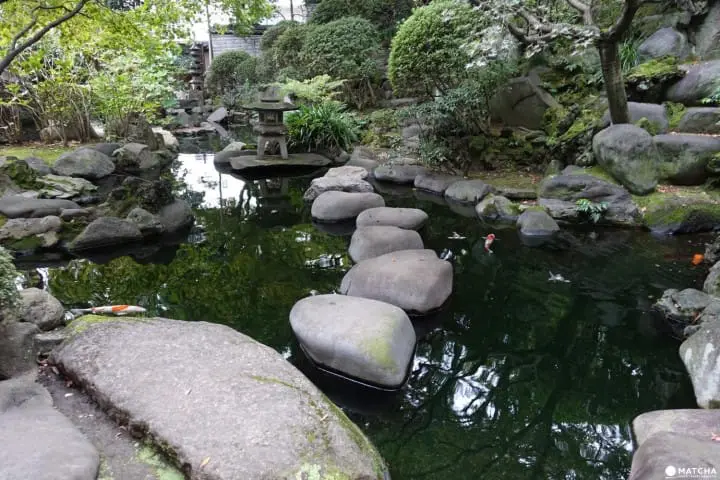Its Symbol Is A Daikon Radish?! Asakusa's Matsuchiyama Shoden Temple

Asakusa is famous for Sensoji Temple and Asakusa Shrine, but there are many hidden power spots all around this historical district. One is Matsuchiyama Shoden, which is said to answer prayers on love, family harmony, and business prosperity.
Asakusa's Hidden Power Spot - For Those in the Know!

When thinking of temples and shrines in Asakusa, the Buddhist temple Sensoji, and its adjacent Shinto shrine, Asakusa Shrine, immediately come to mind, but there are many other recommendable but hidden temples throughout the area. Today we would like to introduce one of them: Matsuchiyama Shoden.
Said to grant prayers regarding fulfillment in love, family harmony, business prosperity and others to its worshipers, this is a temple of thanksgiving. And, with the daikon radish as its distinctive but unusual symbol, you will be able to find daikon radish designs throughout the grounds.
A place that makes you feel thankful, and one that is very interesting to stroll through the grounds of, let's take a look at Asakusa's Matsuchiyama Shoden.
What's Matsuchiyama Shoden Like?

The official name of Matsuchiyama Shoden is Honryuin. First built in the year 601, this temple has an ancient and honorable origin, and is where the Buddhist guardian deity, the great sage Kangi-ten (the Japanese Buddhist form of the Hindu god of wisdom Ganesha) is enshrined. It is said that when the citizens of Asakusa were suffering and starving, Kangi-ten took pity on the people and saved them, and they built this temple in order to show their appreciation and gratitude for his kindness.
A temple well-known for its ability to grant a variety of wishes and for drawing the curious to worship from olden times, this temple was also the subject of numerous ukiyo-e and poems during the Edo era.
Looking Around the Matsuchiyama Shoden Precincts
Kangi Jizo

Immediately after climbing the stairs you will find the Kangi Jizo statue. Jizo is the patron deity of child rearing and child protection and is often visited by those who are raising children, to pray for their safety and happiness, and by those wanting to have children.
Shusse Kannon Statue

Standing opposite the Kangi Jizo is the Shusse Kannon, a statue said to have been made in the 1600s. The word 'shusse' in Japanese means 'success in life' or 'moving ahead in your life/career', and for that reason, the Shusse Kannon is the patron deity of those people seeking success in their schooling, the performing arts, or their chosen career path.
Hondo - Main Temple Building

Anyone is welcome to come up and worship at the hondo, or main temple building. One of the things that makes Matsuchiyama Shoden so famous is that here you can make offerings of daikon radishes. Daikon radishes are a purifying food, said to help remove or neutralize any impurities or toxins in the body when eaten, which makes them a marvelous food to use as an offering.
There are many daikon to be used as offerings available by the main temple building. Here and there on the hondo you will also find different carvings and works featuring the daikon, so please have a look around for them.
Every year on January 7th there is a daikon festival within the temple grounds. With offerings of daikon, this is a unique festival of thanksgiving, one that travelers coming to Japan at this time should not miss out on.


Other Highlights Within the Precincts

The guardian deity of the temple, komainu. Used as messengers of the gods, these lion-dogs stand guard and protect Matsuchiyama Shoden.

This is Tsuijihei, a capped mud wall built during the Edo era. The refined appearance of this wall is something that can only be fully appreciated in person.

There are many koi carp swimming about elegantly in this pond. This is the ideal place to spend a relaxing afternoon, or to take a short break.
In Conclusion
Matsuchiyama Shoden is a temple granting wishes on topics ranging from child rearing to success in life. Why not take a moment to refresh not only your body but also your spirit at this temple with a 1400 year long history? Your wish just might come true.
This is the official account of MATCHA's editorial department. Our articles feature useful travel information for visitors to Japan, from how-to guides to recommended places to visit.







































![[Coupon Available] Attention Overseas Winter Sports Fans! Nagano's Sports Depot Has Evolved](https://resources.matcha-jp.com/resize/720x2000/2026/01/05-254819.webp)
![[2 hours from Tokyo ] 10 Quiet and Breathtaking Views of Mount Fuji in Yamanashi Hokuto City , Yamanashi - Part 2](https://resources.matcha-jp.com/resize/720x2000/2025/12/16-253037.webp)
